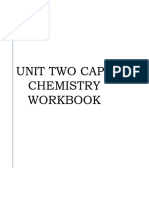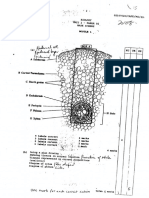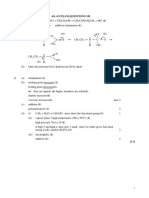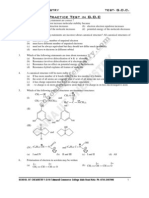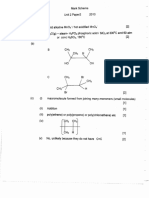Cape Chem 2010 U2 p2 Ms
Cape Chem 2010 U2 p2 Ms
Uploaded by
Yagna LallCopyright:
Available Formats
Cape Chem 2010 U2 p2 Ms
Cape Chem 2010 U2 p2 Ms
Uploaded by
Yagna LallOriginal Description:
Original Title
Copyright
Available Formats
Share this document
Did you find this document useful?
Is this content inappropriate?
Copyright:
Available Formats
Cape Chem 2010 U2 p2 Ms
Cape Chem 2010 U2 p2 Ms
Uploaded by
Yagna LallCopyright:
Available Formats
Mark Scheme
Unit 2 Paper2 2010
Module I
1 (a) (i) eold alkaline MnO+- / het acidified MnOa- tzl
( ii) HaO(g) - stcam- H3POa phosphoric acid / sioz at 300oc and 60 atm
or conc HzSO+, 180oC tZ]
(b)
B CHs CHa
Hg
HO OH
a CHs Br'
CHs
C H
Br l2l
(c) (i) macromolecule formed from joining many monomers (small molecules)
t1l
(ii) Addition t1l
(i ii) poly(ethene) or poly(propene) or poly(chloroethene) etc t1I
(iv) Hg
Hs t11
(v) No, unlikely because they do not have C=C t21
(d) H
H I
N C €
H
I
o-H
R t1I
(e) They both contain the amide linkage
OH
llr
C-N _ t1l
The amide linkages are separated by one C atom in proteins, but in nylon 6,6
they are separated by several C atoms. t1l
Module 2
2 (a) (i) Electromagnetic radiation - oscillating electric and magnetic fields of
energy which can be transmitted through space'
(ii) Wavelength is the distance between successive peak of waves of
radiation.
(iii) Frequency is the number of waves passing a particular point /sec
t3l
(b) (i) 1x10-5m t1l
(ii) 7,5 x 107 Hz t1I
(iii) tR t1l
(iv) Radiowaves [1]
(c) (i) (a) if sample is solid weigh a small amount in a beaker, if liquid
measure 2 cm3 into a beaker;
(b) add 1o cm3 of solvent usually water to the beaker;
(c)transfer the solution and washings to a 50 cm3 volumetric
flask,
distilled water
add chromogenic agent if necessary and dilute to the mark with
or chosen solvent t3I
(ii) Any two of the following;
- StabilitY
. Ability to develop colour with sample
- Transparency in uv/vis region
- Ability to function in a common solvent
- Freedom from interference by other solvenV constituents [2]
(d) (i) E = 6.63 x 10'3a Js x 1.5 x 101s s-1
= 9.9 x 10-1s J
(ii) Emoh = Emelgrlrh X L
= 9.9 x 1o-le J x 6.02 x 1023 mol-1
= 6 x 105 J mol-1 = 600 kJ mol-1
Module 3
3 (a) (i) COz, NOz, SOz anY two tzl
(ii) COz - respiration, SOz - volcano eruptions; NOz - lightning storm t2I
(iii) COs + HzO = HzCOsi or SO2 + HzO = HzSOs,
or 3NOz + HzO 2HNOo + ) NO 121
(b) (i) electric power generation that relies on burning fossil fuels like coal ,
which can be contaminated with sulphur
Burning of gasoline in vehicles in heavily populated areas- there is often
incomplete combustion of gasoline generation NO, 121
(ii) -destroys aquatic life
- leaches soil nutrients
vegetation
- destroys 121
(c) (i) pipe has no leak t1l
(ii) iodide ions,l-'for Pbz*; t1I
(Brown ring test) or A! (or Zn). NaOH in xs
feSOs/conc HaSO*
and warm -test for NHs- (Devarda's alloy test) t1]
(iii) yellow ppt - Pblz t1l
Brown ring at junction of conc acid and rest of solution; or
red litmus turns blue in Devarda's alloy test I1l
Section B
Module 1
4 (a) A and B have the same molecular formula, CeHsO, but diftrenl
structuraiformulap - atoms are linked differently. t2l
(b) alkene and 10 alcohol 121
(cXi) HHHHHHHH
llA,
H-C
lll
-C{+C-C-C =C-Q -H
I
ttl-tl
HO H CHgH H
I
H
(ii) H H
C eis t1l
,/'
c H3-r H-CHz-e Hz-CHz CHzOH
CHc
H CHeOH
t"=/ trans isomer t1]
,/\
CH3-CT-CHz-CHz-CHz t{
eHs
There is no asymmetric or chiral C therefore no optical isomerism t1I
(d) (i) Cracking is the sptitting of larger alkane molecules to smaller ones together
with the formation of an alkene. This requires high temperature or moderate temp and a
catalyst.
(ii) (a) CsHra * C+Hro + CeHa t1l
(b)
Bubhle eaeh gas separately into brown bromine
in an inert solvent . The
alkanc C+Hro will have ns effeet and the alkene
c+Ho will immediately decolourise it.
[3]
Module 2
5 (a)
r Distinguish between motecules of similar
M,
r prediction of posslble identity of
simple organic morecute based on fragmentation
pattern
o Determination of the number of c atoms in the morecure based on M and
peaks M+1
o Identify the presence of atoms such as
cr or bromine from the M+2 peak
a
abundance
Relative isotopic
any three
t3l
(b) (i) M=78; M+1 =7g
121
(ii) (CH:CHCHs)* = 43 (CHeCH3sCl)* = 63 (CH.CH3TC;)* = 65
lsl
(ii i) M = CHg CH35CICHs M+! = CHs eH3scll3CHs
tzl
Name:2-ehloropropane
t1l
(c) Ar (RAM) = ((7s.77t100) x g4.92) + (24.231100)
x 36.96 = z6.s +8.9s
= 35.85
(d) Any two of the following
. Separation of dyes
. Pesticide analysis
r Forensic testing
. Purification of natural products
Module S
(a) Eractional distiilatisn of
liouid,air
(b) (i) Hydrotysis 121
(ii) CHa(g) + Hzo(g) CO(g) + gHa(9) IU
= balance[1 ] formutae[1
]
(c) conditions of optimum yierd
: High pressure favours row vorume
Low temperature favours fonnrard t1l
exothermic reaction
t1l
(d) The Haber process uses the compromise pressure of 250 atm and
moderate temperature (550oC) with Fe catalyst to increase rate I2l
(e) Table 2
Pollutant Source Polluting Effect
NOs- Fertilizers Eutrophication/ algal
Untreated sewage bloom/ lowers Oz for
u marine life
Eutrophication / algal
t1l
PO4- Detergent
Fertilizers bloom
Untreated sewage tU:- I1l
Pipes, paints, car Carcinogenic, cumulative
Pb2* batteries poison
t1l l1l
You might also like
- CAPE Chemistry U2 P2 2004 2018 Solutions PDFDocument108 pagesCAPE Chemistry U2 P2 2004 2018 Solutions PDFvalrie bryan100% (5)
- Chemistry Unit 2 Paper 2 (Solutions) - 1 PDFDocument66 pagesChemistry Unit 2 Paper 2 (Solutions) - 1 PDFDe'arra Brooks90% (10)
- CAPE Caribbean Studies 2018 P2 MS PDFDocument16 pagesCAPE Caribbean Studies 2018 P2 MS PDFLexi JohnNo ratings yet
- CAPE Physics Unit 2 2016 Mark SchemeDocument16 pagesCAPE Physics Unit 2 2016 Mark SchemePeter DePoint67% (6)
- CAPE Biology 2006 U2 P2 MSDocument21 pagesCAPE Biology 2006 U2 P2 MSYagna LallNo ratings yet
- CAPE Biology 2006 U2 P2 MSDocument21 pagesCAPE Biology 2006 U2 P2 MSYagna LallNo ratings yet
- CAPE Physics 2017 U1 P2 Mark SchemeDocument15 pagesCAPE Physics 2017 U1 P2 Mark SchemeTiffany PanchumNo ratings yet
- CAPE Chemistry Unit 2 Paper 2 2017 AnswersDocument12 pagesCAPE Chemistry Unit 2 Paper 2 2017 Answersemanuel coates100% (9)
- CAPE Biology 2004 U2 P2 MSDocument22 pagesCAPE Biology 2004 U2 P2 MSYagna Lall100% (2)
- CAPE Chemistry Unit 2 Paper 1 2007-2017Document108 pagesCAPE Chemistry Unit 2 Paper 1 2007-2017CAPE_PP77% (31)
- CAPE Biology 2004 U2 P2 MSDocument22 pagesCAPE Biology 2004 U2 P2 MSYagna Lall100% (2)
- CAPE Unit 2 Chemistry NotesDocument207 pagesCAPE Unit 2 Chemistry NotesAshley Cunningham100% (2)
- Cape Chemistry 2012 U2 p2 MsDocument9 pagesCape Chemistry 2012 U2 p2 MsYagna LallNo ratings yet
- CAPE 2015 - Suggested AnswersDocument16 pagesCAPE 2015 - Suggested Answerssoumya12355% (11)
- CAPE Biology 2016 U2 P2 MSDocument12 pagesCAPE Biology 2016 U2 P2 MSYagna Lall100% (3)
- CAPE Biology 2008 (Rest of Region) U1 P2 MSDocument11 pagesCAPE Biology 2008 (Rest of Region) U1 P2 MSYagna LallNo ratings yet
- CAPE Biology Unit 1 Paper 2 2017 Question 5Document2 pagesCAPE Biology Unit 1 Paper 2 2017 Question 5Kemoy Francis75% (4)
- CAPE Caribbean Studies MCQ Answers 2019Document1 pageCAPE Caribbean Studies MCQ Answers 2019Damelia Stewart0% (1)
- CAPE Pure Mathematics U2 P1 Answers (2008-2019)Document1 pageCAPE Pure Mathematics U2 P1 Answers (2008-2019)Yagna Lall100% (2)
- CAPE Biology 2016 U2 P2 MSDocument12 pagesCAPE Biology 2016 U2 P2 MSYagna Lall100% (3)
- Process Control Lab ManualDocument338 pagesProcess Control Lab ManualMichael Edwards75% (4)
- Pols CanDocument3 pagesPols CanVisnu SankarNo ratings yet
- Rebound Hammer TestDocument12 pagesRebound Hammer Testmahmood hunar100% (4)
- Cape Chemistry 2011 U2 p2 MsDocument7 pagesCape Chemistry 2011 U2 p2 MsYagna Lall100% (1)
- CAPE Biology 2015 U2 P2 MSDocument18 pagesCAPE Biology 2015 U2 P2 MSYagna Lall100% (2)
- Cape Chemistry 2008 U2 p2 MsDocument14 pagesCape Chemistry 2008 U2 p2 MsYagna LallNo ratings yet
- Cape Chemistry 2015 U2 p2 MsDocument15 pagesCape Chemistry 2015 U2 p2 MsYagna LallNo ratings yet
- CAPE Biology 2011 U2 P2 MS Missing Page 14Document15 pagesCAPE Biology 2011 U2 P2 MS Missing Page 14Yagna LallNo ratings yet
- CAPE Biology 2009 U2 P2 MSDocument12 pagesCAPE Biology 2009 U2 P2 MSYagna Lall100% (1)
- CAPE Chemistry 2013 U2 P2 MSDocument10 pagesCAPE Chemistry 2013 U2 P2 MSYagna Lall100% (2)
- CAPE Biology 2010 U2 P2 MSDocument15 pagesCAPE Biology 2010 U2 P2 MSYagna Lall100% (1)
- CAPE Chemistry U2 P1 Answers 2008 - 2017Document4 pagesCAPE Chemistry U2 P1 Answers 2008 - 2017samuel loweNo ratings yet
- CAPE Biology 2005 U2 P2 MSDocument28 pagesCAPE Biology 2005 U2 P2 MSYagna Lall100% (2)
- CAPE Biology 2013 U2 P2 MS PDFDocument13 pagesCAPE Biology 2013 U2 P2 MS PDFYagna LallNo ratings yet
- CAPE Physics 2012 U1 P2 Mark SchemeDocument7 pagesCAPE Physics 2012 U1 P2 Mark SchemeTiffany PanchumNo ratings yet
- Cape Chemistry Unit 2 p1 Answer SheetDocument2 pagesCape Chemistry Unit 2 p1 Answer SheetchanNo ratings yet
- Caribbean Studies p2 Answers XXXDocument40 pagesCaribbean Studies p2 Answers XXXJonaé Davidson MadamLegacyNo ratings yet
- CAPE Biology 2004 U2 P1 MSDocument12 pagesCAPE Biology 2004 U2 P1 MSYagna LallNo ratings yet
- CAPE Chemistry Unit2 Module3 Industry and The Environment 2013Document24 pagesCAPE Chemistry Unit2 Module3 Industry and The Environment 2013dela267% (3)
- P&D AlcoholsDocument5 pagesP&D AlcoholsBrandon Ramkissoon100% (1)
- CAPE Biology 2007 U2 P2 MSDocument18 pagesCAPE Biology 2007 U2 P2 MSYagna Lall100% (2)
- CAPE Biology U2 P1 Answers PDFDocument1 pageCAPE Biology U2 P1 Answers PDFKevin RogersNo ratings yet
- CAPE Biology 2014 U2 P2 MSDocument13 pagesCAPE Biology 2014 U2 P2 MSYagna LallNo ratings yet
- CAPE 2003 BiologyDocument22 pagesCAPE 2003 BiologyTravis Satnarine33% (3)
- CAPE Biology 2008 Rest of Region U2 P2 MSDocument13 pagesCAPE Biology 2008 Rest of Region U2 P2 MSYagna LallNo ratings yet
- Cape Chemistry Unit 2 p1 Answer SheetDocument2 pagesCape Chemistry Unit 2 p1 Answer SheetJamal Joseph91% (43)
- Cape Chemistry Unit 2 p1 Answer SheetDocument2 pagesCape Chemistry Unit 2 p1 Answer Sheetvalrie bryanNo ratings yet
- Cape 2003 Unit 1 Paper 2Document12 pagesCape 2003 Unit 1 Paper 2petey78No ratings yet
- Biology U2 Paper 1 Answers 2010-2021Document1 pageBiology U2 Paper 1 Answers 2010-2021Amarah Mohammed100% (1)
- CAPE Chemistry Unit 2 Study Notes 2 - Flipbook by Media - FlipHTML5Document112 pagesCAPE Chemistry Unit 2 Study Notes 2 - Flipbook by Media - FlipHTML5SwishanieNo ratings yet
- Cape Biology U2 P1 2007 - 2015 (Answers)Document1 pageCape Biology U2 P1 2007 - 2015 (Answers)C.90% (10)
- CAPE Biology U1 P1 AnswersDocument2 pagesCAPE Biology U1 P1 AnswersDaniel Roopchand100% (1)
- CAPE Physics 2016 U1 P2 Mark SchemeDocument12 pagesCAPE Physics 2016 U1 P2 Mark SchemeLeah CassieNo ratings yet
- Caribbean Studies MCQ SolutionsDocument2 pagesCaribbean Studies MCQ Solutionsabby jacksonNo ratings yet
- Cape Chemistry Unit 1 Paper 2 - May 2011Document9 pagesCape Chemistry Unit 1 Paper 2 - May 2011asjawolverine100% (8)
- Cape Communication Studies: Practical Exercises for Paper 02 EssaysFrom EverandCape Communication Studies: Practical Exercises for Paper 02 EssaysNo ratings yet
- Jamaica Driver's Education Handbook: A Comprehensive Driver Training GuideFrom EverandJamaica Driver's Education Handbook: A Comprehensive Driver Training GuideNo ratings yet
- 4.08-4.09 Amino Acids and Polymers MSDocument9 pages4.08-4.09 Amino Acids and Polymers MSpillboxsesame0sNo ratings yet
- Mark SheetDocument8 pagesMark SheetLearn With SaadiNo ratings yet
- Carbon Compound p2 - AnswerDocument8 pagesCarbon Compound p2 - AnswerzarifNo ratings yet
- Adobe Scan Sep 05, 2023Document8 pagesAdobe Scan Sep 05, 2023harshrajclass9brollno.21No ratings yet
- 24 Hydrocarbon Set Test Final EDocument3 pages24 Hydrocarbon Set Test Final EKumar kartikeyNo ratings yet
- PGDIRI Paper IV - 2016 PDFDocument4 pagesPGDIRI Paper IV - 2016 PDFVinod KumarNo ratings yet
- 4.2.2 Polyesters and Polyamides MSDocument3 pages4.2.2 Polyesters and Polyamides MSpillboxsesame0sNo ratings yet
- Organics, Synthesis and Enthalpy MSDocument47 pagesOrganics, Synthesis and Enthalpy MSAnh Nguyễn VănNo ratings yet
- ChemistryDocument12 pagesChemistryAditya SinghNo ratings yet
- Set of 50 Obj in General Organic Chemistry by S.K.sinha HTTP://WWW - Openchemistry.inDocument6 pagesSet of 50 Obj in General Organic Chemistry by S.K.sinha HTTP://WWW - Openchemistry.inmyiitchemistry50% (4)
- Working Items Involving Equivalent Fractions: ThursdayDocument3 pagesWorking Items Involving Equivalent Fractions: ThursdayYagna LallNo ratings yet
- Chapter 43. WartsDocument12 pagesChapter 43. WartsYagna LallNo ratings yet
- Chapter 36. Diaper Dermatitis and Prickly HeatDocument14 pagesChapter 36. Diaper Dermatitis and Prickly HeatYagna LallNo ratings yet
- Igcse June 2015 Question Paper 21Document16 pagesIgcse June 2015 Question Paper 21Yagna LallNo ratings yet
- CAPE Pure Maths 2019 U2 P1Document8 pagesCAPE Pure Maths 2019 U2 P1Yagna Lall100% (1)
- Cambridge IGCSE: Additional Mathematics For Examination From 2020Document12 pagesCambridge IGCSE: Additional Mathematics For Examination From 2020Yagna LallNo ratings yet
- Chapter 7 Sequences: Try These 7.1Document14 pagesChapter 7 Sequences: Try These 7.1Yagna LallNo ratings yet
- Cape Chem 2010 U2 p2 MsDocument6 pagesCape Chem 2010 U2 p2 MsYagna LallNo ratings yet
- CAPE Biology 2005 U2 P2 MSDocument28 pagesCAPE Biology 2005 U2 P2 MSYagna Lall100% (2)
- CAPE Biology 2011 U2 P2 MS Missing Page 14Document15 pagesCAPE Biology 2011 U2 P2 MS Missing Page 14Yagna LallNo ratings yet
- 0606 Additional Mathematics: MARK SCHEME For The May/June 2015 SeriesDocument5 pages0606 Additional Mathematics: MARK SCHEME For The May/June 2015 SeriesYagna LallNo ratings yet
- CAPE Biology 2007 U2 P2 MSDocument18 pagesCAPE Biology 2007 U2 P2 MSYagna Lall100% (2)
- CAPE Biology 2004 U2 P1 MSDocument12 pagesCAPE Biology 2004 U2 P1 MSYagna LallNo ratings yet
- CAPE Biology 2009 U2 P2 MSDocument12 pagesCAPE Biology 2009 U2 P2 MSYagna Lall100% (1)
- CAPE Biology 2013 U2 P2 MS PDFDocument13 pagesCAPE Biology 2013 U2 P2 MS PDFYagna LallNo ratings yet
- CAPE Biology 2008 Rest of Region U2 P2 MSDocument13 pagesCAPE Biology 2008 Rest of Region U2 P2 MSYagna LallNo ratings yet
- CAPE Chemistry 2013 U2 P2 MSDocument10 pagesCAPE Chemistry 2013 U2 P2 MSYagna Lall100% (2)
- CAPE Biology 2010 U2 P2 MSDocument15 pagesCAPE Biology 2010 U2 P2 MSYagna Lall100% (1)
- CAPE Biology 2014 U2 P2 MSDocument13 pagesCAPE Biology 2014 U2 P2 MSYagna LallNo ratings yet
- Vibro SifterDocument3 pagesVibro SifterRaj K SharmaNo ratings yet
- Applications of Molecular and Materials ModelingDocument455 pagesApplications of Molecular and Materials ModelingBENCHALGONo ratings yet
- Chapter 2Document48 pagesChapter 2KelleyNo ratings yet
- Strain EnergyDocument10 pagesStrain EnergyJayakumar VenkataramanNo ratings yet
- BEE3133 Electrical Power Systems: Transmission Line ParametersDocument84 pagesBEE3133 Electrical Power Systems: Transmission Line ParametersLittle CandyNo ratings yet
- ME6604-Gas Dynamics and Jet PropulsionDocument116 pagesME6604-Gas Dynamics and Jet PropulsionMohanraj Subramani0% (1)
- Reading Assignment 8 Williams CHP 3Document34 pagesReading Assignment 8 Williams CHP 3Isaac HanssenNo ratings yet
- Project ProposalDocument11 pagesProject ProposalKevin Christian PlataNo ratings yet
- Re92711 2012-01Document48 pagesRe92711 2012-01Edson Huarachi FloresNo ratings yet
- SukanyaKarmakar 74Document23 pagesSukanyaKarmakar 74sukanya karmakarNo ratings yet
- General Physics 2: Electric Flux and Gauss's LawDocument8 pagesGeneral Physics 2: Electric Flux and Gauss's LawMarlon TrinidadNo ratings yet
- ASES2012 Zhang Stewart Brownson WitmerDocument9 pagesASES2012 Zhang Stewart Brownson Witmersamson kabasaNo ratings yet
- What Is Welding Inspector ?: DefinisiDocument20 pagesWhat Is Welding Inspector ?: DefinisiBagasAdiNugroho100% (1)
- Analysis of Variance of Hardness of Machete Bolo: Submitted To: Dr. Vannie Joy T. ResabalDocument3 pagesAnalysis of Variance of Hardness of Machete Bolo: Submitted To: Dr. Vannie Joy T. ResabalMichael Vincent MirafuentesNo ratings yet
- Why Light Is A Pure EnergyDocument3 pagesWhy Light Is A Pure EnergyAleah Marie AsperinNo ratings yet
- Civil Engineering Journal 6th Issue 2020Document184 pagesCivil Engineering Journal 6th Issue 2020Ivan MuhammadNo ratings yet
- EDC UNIT - II Previous QuestionsDocument1 pageEDC UNIT - II Previous QuestionssandeepecetNo ratings yet
- ISOC Control GenreatorsDocument4 pagesISOC Control GenreatorsStuart Robinson100% (2)
- Silicon Avalanche Photodiodes On The Base of Metal Resistor Semiconductor Structures PDFDocument7 pagesSilicon Avalanche Photodiodes On The Base of Metal Resistor Semiconductor Structures PDFlaboratorNo ratings yet
- Drag Coefficient RoscarlDocument7 pagesDrag Coefficient RoscarlRoscarl GorospeNo ratings yet
- Brawn Laboratories Limited: Standard Operating ProcedureDocument4 pagesBrawn Laboratories Limited: Standard Operating ProcedureAshok LenkaNo ratings yet
- KaldorsDocument7 pagesKaldorsArbin KhatriNo ratings yet
- How Nanorobots Will WorkDocument8 pagesHow Nanorobots Will WorkshivangivighNo ratings yet
- Analysis of Effect of Structural Irregularity in Multistorey Building Under Seismic LoadingDocument8 pagesAnalysis of Effect of Structural Irregularity in Multistorey Building Under Seismic LoadingBehroz BehzadNo ratings yet
- Introduction To Vibration Problems at Compressor StationsDocument113 pagesIntroduction To Vibration Problems at Compressor Stationssatya_chaganti100% (1)
- Digital Density Gauge Model SS200. Instruction Manual. Version 2.7. SIStec. Specialised Industrial SystemsDocument97 pagesDigital Density Gauge Model SS200. Instruction Manual. Version 2.7. SIStec. Specialised Industrial SystemsMichael adu-boahenNo ratings yet
- Sikagrout - 295: Cement-Base Fluid Expanding Mortar, With High Mechanical ResistanceDocument2 pagesSikagrout - 295: Cement-Base Fluid Expanding Mortar, With High Mechanical Resistancethe pilotNo ratings yet









